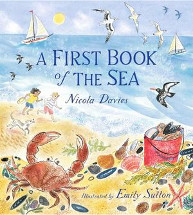A first book of the sea by Nicola Davies

Ill. by Emily Sutton. Walker Books, 2018. ISBN 9781406368956
(Ages: 3-7) Highly Recommended. Themes: Poetry. Oceans. Emily Sutton
is a whimsical, traditional illustrator, whose work is perfectly
suited to this earthy, old-fashioned and hearty collection of poems.
The author and illustrator have collaborated successfully in the
past on Tiny and Lots, and have now put together a hardcover
book with over fifty short poems, perfect as a first book of poems
for young ones but will also interest junior primary children. The
poems are about oceans and ocean life and celebrate the vastness,
mystique and intrigue of the great blue world that surrounds us. The
book is separated into four categories, as shown within a contents
page: down by the shore (Catching a wave, Paddling, Shore crab),
journeys (Limpets, Sailor's jig, Blue whale's map), under the sea
(Longline fishing, Seaweed jungle, Shipwreck) and wonders (Rockpool,
Albatross, Sea people). The poems are helpfully titled so you know
what each is going to be about and can pick based on children's
interests. They also seem carefully curated to include favourite
aspects of young readers (shipwrecks, deadly sea animals, sharks,
giant squid, etc.).
The illustrations, beautifully textured and intricately detailed,
are perfect and because of the large format and the brevity of the
poems, are full partners rather than just an afterthought. While the
author and illustrator are English the book isn't identifiably so
(except for the poem about big shopping and entertainment piers that
are not a feature of Australian beaches). The poems evoke the
feelings of being in and around the sea, such as the thrill of
catching a wave or searching for shells, but they also provide
fascinating information that reminds us of the power and long
history of the world's oceans ("The sea has shaped them, rubbing and
rolling, rolling and rubbing, for a thousand, thousand years"). They
remind us of how to take care of our oceans ("Deadliest of all is
the plastic we throw away that strangles, suffocates and poisons").
They inform us of the wisdom of those who live in harmony with the
sea ("the old man draws the night sky out in pebbles to teach his
grandson the pattern of the stars") and about how man has learned to
deal with the wildness of the sea ("From one to twelve runs
Beaufort's Scale, to tell ships when it's safe to sail"). There are
a wide variety of poem styles, some rhyming but most not.
There are many conversation points within the book and some poems
openly encourage children to engage with the book (in "Favourite
dolphin" the only text asks "Choose just one? It's impossible to
pick!" and shows a plethora of dolphins of different varieties). The
big fold-out page for the large humpback whale tells the reader how
to sing like a humpback. The last poem, "Happiness", is a reminder
of the simple pleasures of the sea ("Sand in my shoes. Salt in my
hair. A pebble in my pocket. The horizon in my eyes"). Simple,
evocative, glorious.
Nicole Nelson